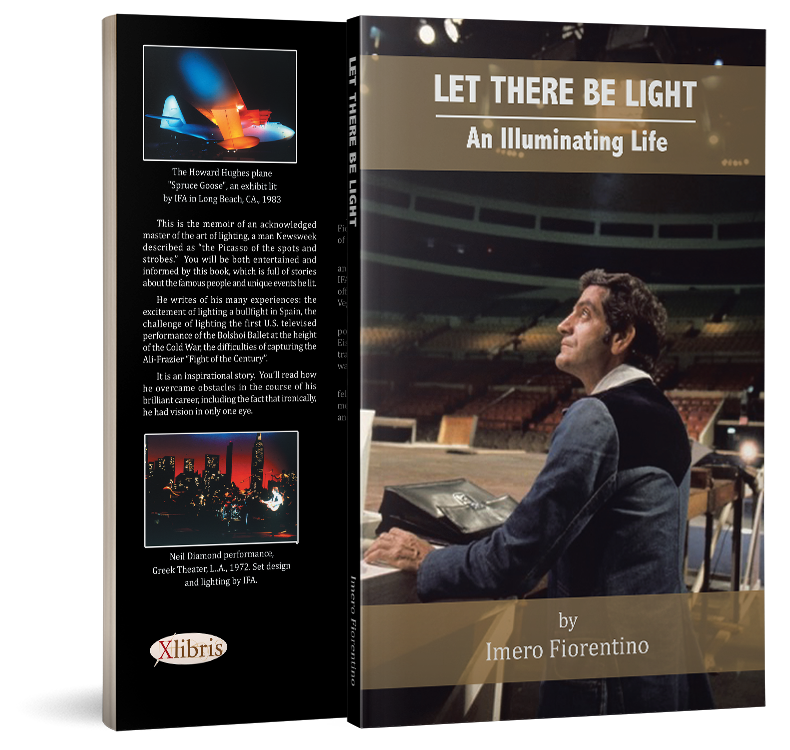 Let There Be Light: An Illuminating Life
Let There Be Light: An Illuminating Life
This is the memoir of an acknowledged master of the art of lighting, a man Newsweek described as “the Picasso of the spots and strobes.” You’ll be both entertained and informed by this book, which is full of stories about the famous people and unique events he lit.
He writes of his many experiences: the excitement of lighting a bullfight in Spain, the challenge of lighting the first U.S. televised performance of the Bolshoi Ballet at the height of the Cold War, the difficulties of capturing the Ali-Frazier “Fight of the Century.”
It is an inspirational story. You’ll read how he overcame obstacles in the course of his brilliant career, including the fact that, ironically, he had vision in only one eye.
The following is a review of Let There Be Light by the Editor of Primo Magazine
LET THERE BE LIGHT
An Illuminating Life
By Imero Fiorentino
Call to order 1-888-795-4274
Or log on: www.imerosmemoir.com
Lights, camera, action!
The famous command of television directors – at least the first part of it – was often relegated to the ingenuity of Imero Fiorentino.
Now comes his memoir “Let There Be Light;” a record of one man’s extraordinary technical achievements in America’s entertainment industry.
Son of Italian immigrants, Fiorentino was responsible for lighting television shows and live events in a career that spanned decades. He was a true pioneer in his field who once worked for ABC in the 1950s when programs were broadcast live. A graduate of Carnegie-Mellon, Fiorentino created many of the lighting techniques that are commonplace today in television.
“Let There Be Light” is a wonderful book about a fine Italian American. Fiorentino did the lighting for political debates and conventions, the Muhammad Ali and Joe Frazier bout at Madison Square Garden in 1971, the Bolshoi ballet’s first televised performance in 1959; Frank Sinatra, the Main Event, 1974 and the California Jam on ABC in 1974 that featured Deep Purple, the Eagles, Black Sabbath, and more.
One of his first jobs was creating the lighting for “Pulitzer Prize Playhouse,” a live drama series on ABC in the 1950s, that featured, among others, Ralph Bellamy, Anne Bancroft, and Grace Kelly.
“The work was demanding and loaded with pressure,” the author writes. “The hours were long – fifteen – to eighteen-hour days, seven days a week – but there were no complaints from me.”
Although Sicilian, Fiorentino was well-known for his calm composure. There was only one occasion when he lost his cool. Director Alex Segal “…was insisting on a lighting effect that simply couldn’t be done…and I sailed my clipboard across the room…I retrieved the damaged clipboard and made up my mind to keep it and to never use another…One corner is missing and it looks pretty shabby. I love that clipboard.”
Fiorentino was a good friend of PRIMO’s who once wrote a piece for our Readers’ Corner department titled “Mammina Power,” about his no-nonsense and deeply devoted Sicilian mother. Thus, we welcome his new book, albeit on a bittersweet note. Fiorentino died in 2013 and his surviving wife Angela made it her mission to get the book published posthumously.
We’re glad she did.
“Let There Be Light,” is an entertaining and historic account of a true television pioneer. Fiorentino retells a life lived to the highest levels of craftsmanship and professional acumen. “Let There Be Light” should be read by anyone who loves the art of television, cinema, and live events. This book reminds us what it takes to be the best at what one does.

